We encourage all users to utilize the backup and restore functionality available in both the free and paid versions of the Cashflow application. The backup & restore feature will allow users to export or import their entire database to a comma-separated value (CSV) text file stored either in your device’s internal memory (some devices may save to a SD card) or to Dropbox. Backups stored locally on the device can then be copied off of the device either by emailing oneself a the file using the ‘Email Backup File’ feature, or by simply copying it to a PC over a USB connection. This is helpful for moving data between phones (new or replacements), or for having the ability to recover should a phone be damaged or lost. Regular backups stored off of the device are the best protection against potential data loss. For this reason, we strongly suggest using the Dropbox feature for easy and automatic off-device (cloud) storage of the backups.
Backup
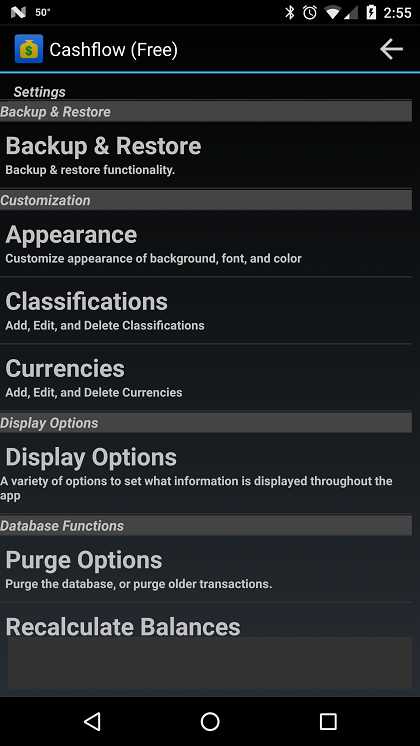
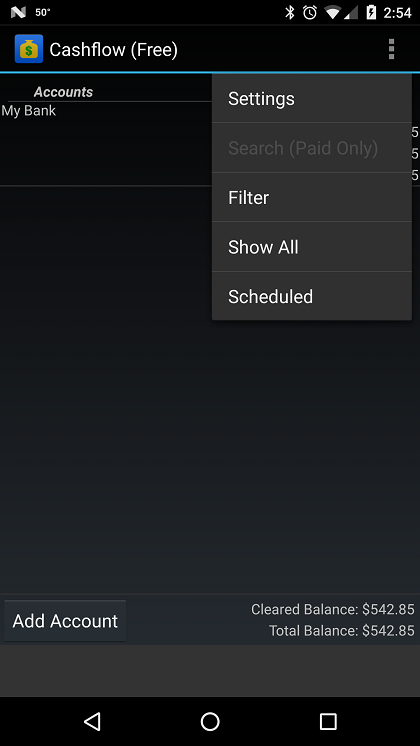 Open Cashflow and press the Menu button from the Accounts screen. Select ‘Settings’. Scroll down the Settings screen and select ‘Backup & Restore’.
Open Cashflow and press the Menu button from the Accounts screen. Select ‘Settings’. Scroll down the Settings screen and select ‘Backup & Restore’.
Local Storage or Dropbox?
 The Backup & Restore menu gives you two choices. Local Backup & Dropbox. If you have a Dropbox account and have the Dropbox app installed on your phone, you can use the Dropbox option, otherwise use the Local Storage option. It is strongly suggested that you use the Dropbox feature so that your backups are stored in the cloud rather than on the device, as a lost or broken device could render the local backup inaccessible.
The Backup & Restore menu gives you two choices. Local Backup & Dropbox. If you have a Dropbox account and have the Dropbox app installed on your phone, you can use the Dropbox option, otherwise use the Local Storage option. It is strongly suggested that you use the Dropbox feature so that your backups are stored in the cloud rather than on the device, as a lost or broken device could render the local backup inaccessible.

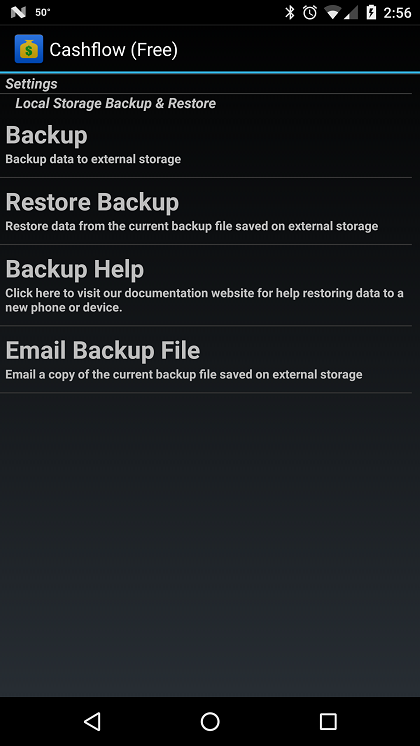 Both the Dropbox and Local Storage screens have similar options. Click the Backup button and wait until the backup is complete. Once the backup is complete, a file named Cashflow.Backup.csv will be saved in a directory named ‘cashflow’ on your device if you used the Local Storage option or in your Dropbox “Apps” folder if you used the Dropbox option.
Both the Dropbox and Local Storage screens have similar options. Click the Backup button and wait until the backup is complete. Once the backup is complete, a file named Cashflow.Backup.csv will be saved in a directory named ‘cashflow’ on your device if you used the Local Storage option or in your Dropbox “Apps” folder if you used the Dropbox option.
Email Backup File
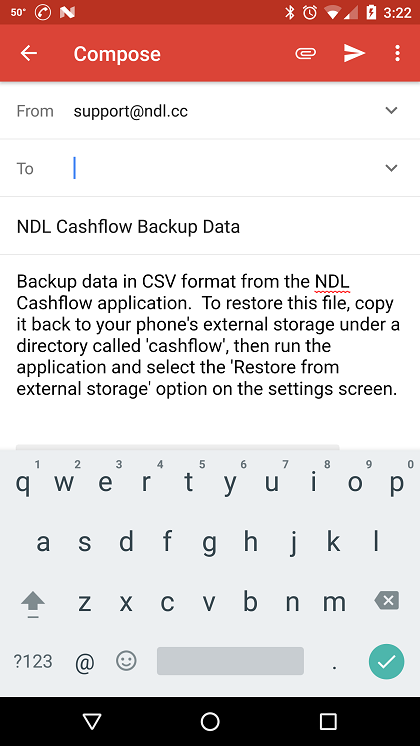 As a convenience to users that use the Local Storage backup option that wish to keep a copy of their backup files off of the device, we’ve included an option to email the file. On the Local Storage Backup Menu, you will find an option ‘Email Backup File’. When clicked, this option will attempt to generate an email, attaching the backup file created earlier. You will be prompted to select an application to send an email from. In our example, we selected Gmail. Notice that Gmail will now require you to fill in an email address to send the file to. The subject, attached file, and body of the email will be filled in automatically. Note that the body of the email includes basic directions for restoring that file to the phone. Most users will probably use this feature to email the file to themselves as an alternative to connecting the phone by USB to manually copy the backup.
As a convenience to users that use the Local Storage backup option that wish to keep a copy of their backup files off of the device, we’ve included an option to email the file. On the Local Storage Backup Menu, you will find an option ‘Email Backup File’. When clicked, this option will attempt to generate an email, attaching the backup file created earlier. You will be prompted to select an application to send an email from. In our example, we selected Gmail. Notice that Gmail will now require you to fill in an email address to send the file to. The subject, attached file, and body of the email will be filled in automatically. Note that the body of the email includes basic directions for restoring that file to the phone. Most users will probably use this feature to email the file to themselves as an alternative to connecting the phone by USB to manually copy the backup.
Restore Dropbox Backup File

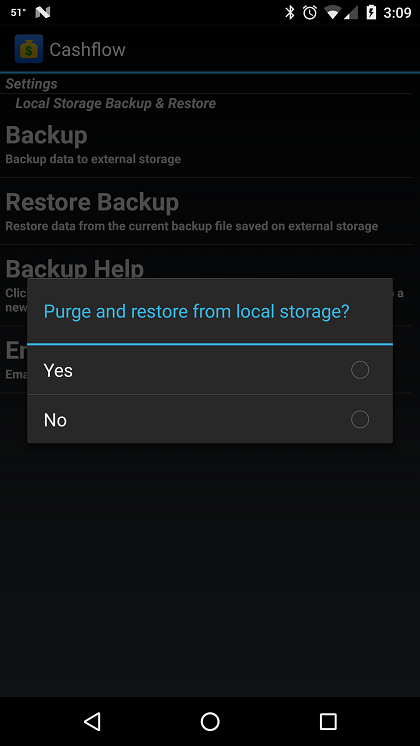 Open Cashflow and press the Menu button from the Accounts screen. Select Settings, then Backup & Restore, then Dropbox. On the Dropbox screen click the Restore button. You will be prompted to confirm that you want to purge the existing database and restore from the backup. Select ‘Yes’. After the restore is complete, press the back button to get to the Accounts screen and verify that your data was restored correctly.Sometimes Dropbox will prompt you to allow the Cashflow app permission to use Dropbox. When this happens, some users may get an error when trying to restore. If that happens, simply click the restore button again.
Open Cashflow and press the Menu button from the Accounts screen. Select Settings, then Backup & Restore, then Dropbox. On the Dropbox screen click the Restore button. You will be prompted to confirm that you want to purge the existing database and restore from the backup. Select ‘Yes’. After the restore is complete, press the back button to get to the Accounts screen and verify that your data was restored correctly.Sometimes Dropbox will prompt you to allow the Cashflow app permission to use Dropbox. When this happens, some users may get an error when trying to restore. If that happens, simply click the restore button again.
Restore Local Storage Backup File
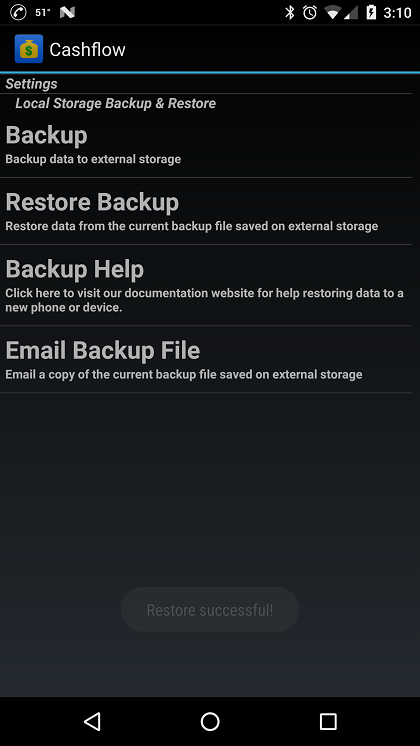
 Assuming the backup file is in the proper place on the SD card (see below if you’re restoring from an emailed backup, or to a new/different phone), open Cashflow and press the Menu button from the Accounts screen. Select Settings, then Backup & Restore, then Local Storage. On the Local Storage screen click the Restore button. You will be prompted to confirm that you want to purge the existing database and restore from the backup. Select ‘Yes’. After the restore is complete, press the back button to get to the Accounts screen and verify that your data was restored correctly.
Assuming the backup file is in the proper place on the SD card (see below if you’re restoring from an emailed backup, or to a new/different phone), open Cashflow and press the Menu button from the Accounts screen. Select Settings, then Backup & Restore, then Local Storage. On the Local Storage screen click the Restore button. You will be prompted to confirm that you want to purge the existing database and restore from the backup. Select ‘Yes’. After the restore is complete, press the back button to get to the Accounts screen and verify that your data was restored correctly.
Local Backup File Location
When creating a backup, the backup file will always be stored in the ‘cashflow’ directory on the device’s SD card. The backup file will be named ‘Cashflow.Backup.csv’. If you are restoring a backup file to a different phone, or from a copy of the file emailed or copied to your PC, you will need to connect your device to your computer using USB. Set your device to act as a USB drive (see device user manual for specific instructions). Navigate to the SD card and create a folder named ‘cashflow’ if it does not already exist. Copy the ‘Casflow.Backup.csv’ file into this folder. Disconnect your device’s USB cable, and follow the instructions above to restore your data.
Error Messages
If you recieve an error message while attempting to backup or restore your database, please verify that your phone is not connected to your computer as a USB drive. When in use as a USB drive, Cashflow cannot access the SD card properly.
Backups Prior to Release 2.06
Cashflow will still support the ability to restore data from older versions of the backup file. Prior to version 2.06, the backup file was named ‘ndlcashflow.backup.xml’ and stored in a directory named ‘ndl_cashflow_data’ on the SD card. When the restore function is run, the application will first check for the existance of a file in the new location (SD://cashflow/Cashflow.Backup.csv). If that file does not exist, it will attempt to restore from the old backup file (SD://ndl_cashflow_data/ndlcashflow.backup.xml). If you need to restore from an old backup file, you will need to manually delete the file ‘Cashflow.Backup.csv’ if it exists in the ‘cashflow’ directory on the SD card. The old version of the backup file will need to be located in the ‘ndl_cashflow_data’ directory.